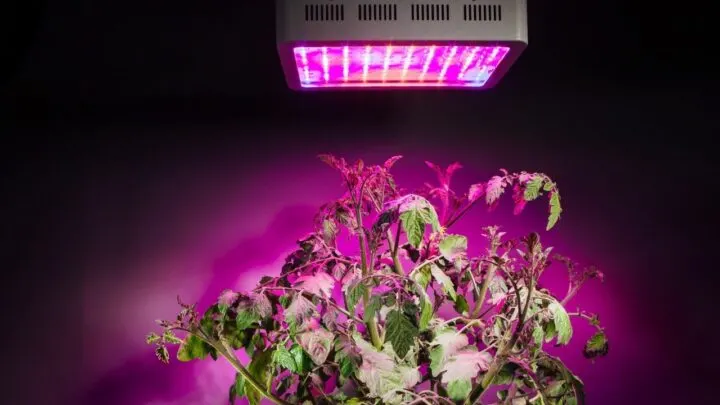Growing a houseplant, especially hydroponic plants, can often require you to arrange for conditions that aren’t readily available.
Now we know that plants require light exposure for a few hours during the day.
And it is not always possible to provide them with natural light solutions, such as the sunlight, specifically when you are growing them indoors.
In such situations, artificial lights, such as the LED grow lights, come in handy.
But first of all, before you make such an investment, let us weigh the pros and cons to make the decision easier for you!
Table of Contents
Are LED grow lights worth it?
LED grow lights are an upgrade from the previous options such as HPS bulbs. The benefits of installing a LED grow light setup are significant. Not only are LED lights compactly arranged, but they can also significantly improve energy consumption and are emitting less heat. In addition, you can often manually adjust the color spectrum and light intensity to match the light needs of plants.
Why using an LED grow light is a great option
When it comes to curating the perfect conditions according to the brightness and warmth requirements for a houseplant, LED grow lights are emerging as a popular choice.
LED grow lights essentially use LED chips, or light-emitting diode chips, for illuminating purposes.
Not every plant needs a grow-light setup to grow indoors, and the ones that do, have varied requirements.
Naturally, before you invest in LED grow lights, it would be great for you to have some information handy.
The kind of lights you should be opting for should be based on the plant you are growing.
Take a look at some of the most fundamental ways in which LED grow lights are leagues ahead of standard solutions in the context of growing houseplants.
Better heat management
The close alternative for LED grow lights are HPS bulbs or High-Pressure Sodium bulbs.
These have been around for a while, and though they were dependable initially, the LED grow lights far outshined them in terms of sustainability and power consumption.
LEDs run at lower heat levels than their HPS counterpart.
This means two things for you.
On one hand, LED grow lights will cut down the ventilation costs, and on the other, the amount of heat your plants will be exposed to will become easier to monitor and manage.
Power and cost-efficiency
LED grow lights run on electricity, yes, but they are highly power-efficient.
Not only can they run on less power compared to the other alternatives you will currently find in the market, but they also offer more concentrated lighting solutions.
At a glance, that means lower energy bills for you. But if you look at the bigger picture, you will be surprised to see what that means for the entire community and the world at large.
Cutting down energy consumption and clean energy utilization can make a huge difference!
Plant oriented lighting solutions
I think it is quite evident that color spectrums are critical for providing adequate lighting for home plants.
Color spectrum requirements vary vastly, and to this effect, failing to provide might just be equivalent to neglecting the needs of your plant in some cases.
LED grow lights are excellent in this regard because most of them will allow you to regulate the color spectrum of the light they emit to suit your plant’s needs better.
Thus, unlike the other alternatives in the market currently, LED grow lights concentrate their lighting efforts to precisely adjust to the needs of your plants by altering the spectrum to facilitate better light absorption.
Efficient space management
Bulky lighting setups can be quite inconvenient, especially if they end up cramping the plants’ space.
No plant parent wants that, so personally, it is quite important to me to ensure that the available space is utilized fully without turning it into too much of a tight fit.
LED grow lights typically aid in better space utilization and management.
The way I look at it, this fact alone places LED grow lights several notches higher than their space-consuming alternatives!
LED Grow Light Drawbacks
While the discussion up until now seems to be leaning heavily in favor of LED grow lights, we can’t just pretend like these indoor plant lights are completely infallible.
Of course, there are a few disadvantages to installing LED grow lights for your houseplants. Let’s have a quick look at them too.
- The Light Emitting Diodes can begin to act up after a while. These lights don’t lack longevity, but once a certain amount of time has passed, they can be somewhat susceptible to the wear and tear of time, and their light spectrum utilities might slowly wane or decline in quality.
- Specifically, if the LED grow lights are subjected to constantly high temperatures, they tend to wear out much more quickly.
- LED can also be responsible for the emission of blue light, proving to be quite harmful to human eyesight. Besides, as a side effect for the emission of concentrated light, the area covered might be reduced, too.
Despite a couple of problems, there are almost no significant drawbacks of LED grow lights, especially compared to the other indoor plant lighting options.

Daniel has been a plant enthusiast for over 20 years. He owns hundreds of houseplants and prepares for the chili growing seasons yearly with great anticipation. His favorite plants are plant species in the Araceae family, such as Monstera, Philodendron, and Anthurium. He also loves gardening and is growing hot peppers, tomatoes, and many more vegetables.


